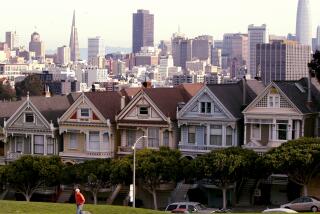Virtual reality homebuying on the horizon
- Share via
Southern California’s home market is so competitive that some buyers make down payments on houses over mobile streaming applications.
Soon, thanks to virtual reality, showing a home may become passé, too.
Calgary, Canada-based builder Brookfield Residential will offer virtual tours of model homes at its new San Marcos home project starting in February. The homes don’t open until spring, but the builder will be showcasing the technology at the Carlsbad Premium Outlets from Feb. 2 to May 1.
While the technology began working its way into real estate circles early last year, this is likely the first time it will be used on a large scale in San Diego County and the first place Brookfield is trying it out.
Brookfield spokeswoman April Harter-Enriquez said the technology is a way to get potential buyers interested in a project before models are ready to open.
“The homebuying process, in general, is a bit of a dinosaur at times,” she said. “(Brookfield) looked at VR technology to really change the homebuying experience by letting people get a taste of what the homes will be like before they are actually built.”
Users of the virtual reality tool will put on a Gear VR head strap that wraps around the front of a person’s face. Users look at an application in front of their eyes running on a Samsung Galaxy S7 phone.
The user can “walk” from room to room in the house, into the bathroom, up the stairs and view details on the ceiling. By looking at targets placed in certain parts of the screen, the software knows to move users to a different location.
The phone application was developed by San Francisco-based Transparent House. The company also recently did a virtual reality tour of San Francisco’s Shipyard, a master planned community by developer Lennar with 12,000 homes and 1 million square feet of retail.
Virtual reality is catching on more. BI Intellegence anticipated a 1047 percent increase of VR headsets shipped in 2016, up to 8.2 million units. But, Transparent House account director David Scott Van Woert said to get the full experience it is best with a full immersion goggle set like the Gear VR, which runs for about $100. Still, he said the company often sends cheaper cardboard virtual reality kits (that cost roughly $15).
To reach as many potential homebuyers as possible, Brookfield opted to showcase the VR tours at a mall.
Van Woert said Transparent House gets weekly requests for new projects. The most recent was for individual homes in Beverly Hills and Palo Alto.
“VR is the next natural evolution in terms of marketing real estate,” he said. “A lot of these companies are very tech-forward and always looking for, not only an edge over competition, but to stay current because expectations of the public are such that they are going to be demanding technology like this.”
There’s also an incentive for real estate agents and companies to show properties as soon as possible, even if it is virtual. San Diego County homes stayed on the market an average 33 days in 2016, said the Greater San Diego Association of Realtors. That was down from 39 in 2015 and 46 in 2014.
Jason Cassity, agent with ISellTheCity real estate in downtown, said he thinks virtual reality will be the future in his industry and something he is eager to use.
“In my opinion, that (technology) should be commonplace already because it is so helpful to buyers,” he said. “You could have someone sitting in Boise, (Idaho), walk through your house and it just does so much more than the photos can. It gives them a sense of how the layout feels.”
Cassity already pays about $300 a listing to do a 3D map of properties through the Matterport platform. Right now, he said not everyone has a pair of virtual reality goggles sitting around but at least distant buyers can walk through the 3D scanned properties.
Other agents and real estate groups have experimented with similar technologies. In late 2015, real estate listening website Redfin launched a “Live Video Tour” function that lets potential buyers watch as an agent walks through a property live-streaming it room to room.
For now, virtual reality might be cost prohibitive. Van Woert said each project is different, but a single room could cost $20,000 to do and a larger project could run up to $100,000.
Brookfield is using virtual reality for its three developments in the Rancho Tesoro: Candela, Terracina and Vientos. Homes range from 2,221 to 3,565-square-feet. At final build-out, the communities will have roughly 275 single-family homes. The price range is anticipated to be from $600,000 to $900,000.
Single-family home construction has become rare in San Diego County and the houses are likely to be a hot commodity when they open in the spring.
Business
phillip.molnar@sduniontribune.com (619) 293-1891 Twitter: @phillipmolnar
ALSO
Would you buy a home on your phone?
More to Read
Sign up for Essential California
The most important California stories and recommendations in your inbox every morning.
You may occasionally receive promotional content from the Los Angeles Times.







